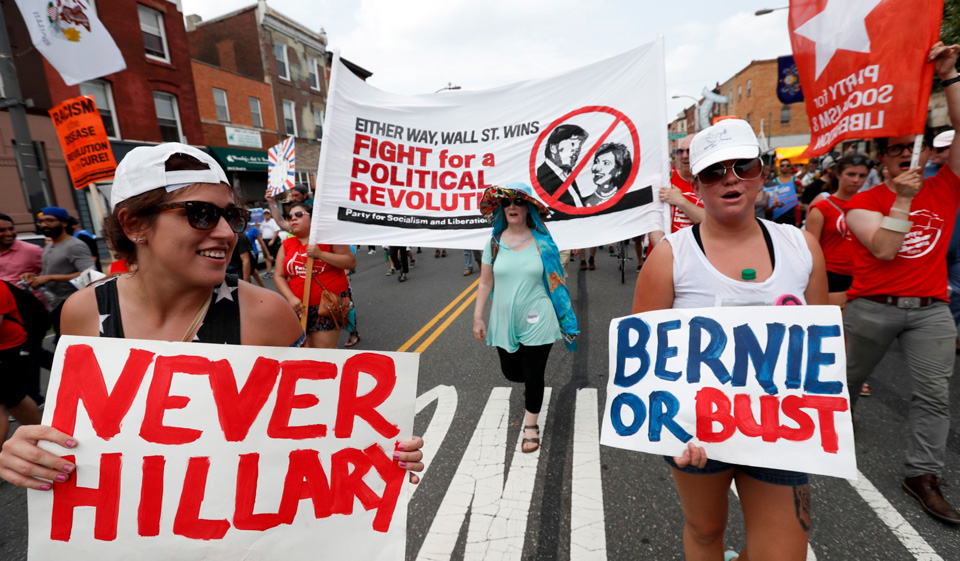
Of all the political certainties shattered by this year’s presidential election, one of the most striking involves left-wing politics. It is a shattered certainty that is celebrated nearly everywhere and examined virtually nowhere. It is the end of the idea of the United Front, a concept that’s been bequeathed to recent generations under the brand of “coalition politics.” To be fair, despite having been authorized by no less a leftist scripture than The Communist Manifesto, the coalition idea has never had unanimous support within left-wing circles.
Yet it was the political strategy that defeated fascism. It helped create and sustain the civil rights and peace movements in our country a half-century ago. A lot of local governments in this country have thrived because of it. It is the kind of “big tent” politics that have supported some of the best recent political, social, and cultural reforms.
The idea, briefly, is this: the radical working class parties always seek ways to build the broadest possible coalition against the most reactionary ones. For Karl Marx and Frederick Engels, this meant making alliances with Social Democrats, Radicals, agrarians, the radical bourgeoisie, and even the bourgeoisie itself, when it fought against absolute monarchy.
One hundred years ago, however, the European Socialist parties compromised this idea. Most European Socialist leaders supported their own bourgeois governments during World War I, and this helped split the movement into “revolutionary” and “reformist” wings. Socialists and Communists began to campaign against all other parties – and each other – in the competition for power.
This changed somewhat after the rise of the Nazis in the mid-1930s. Some sought to revive Marx and Engels’s alliance policy, and promulgated what was called the “United Front Against War and Fascism.” Although the Communist International introduced the idea in 1935, it was welcomed by lots of other people. But not all left-wingers loved it.
In this country, while the Communist Party allied itself with Franklin D. Roosevelt in what the party’s leaders called the “People’s Front,” the Socialist Party condemned the Democratic Party and the New Deal, declaring in its 1936 election campaign platform that “the New Deal, like the Old Deal, has failed.”
In time, many Socialists drew closer to the traditional Communist position, especially during the postwar decades. At the same time that they were embracing the essence of the Communists’ popular front strategy, however, they were focused on shutting the Communists themselves out of it. They joined the Cold War anti-communist crusade, thereby becoming one of the faces of “legal Marxism” in the country.
The two groups competed for influence within the Democratic Party coalition, and disputed about when, where, and how to push the coalition’s limits. The overall aim, however, was to isolate the far right wing and shift the center of gravity of U.S. politics to the left, such that the main competitors for votes and power would be forces roughly identified with the term “left” and those identified with the term “liberal.”
The subsequent history of all this is relatively unimportant, except to note, again, that coalition politics has never been universally loved by all left-wingers. Nevertheless, the Democratic Party now bills itself as a “big tent” party with the most progressive platform in its history. This is, at least in part, the fruit of generations of effort by the pro-coalition left, in alliance with others.
But despite the shift of the Democratic Party toward the left, far too many left-wingers vigorously, vocally, and with both action and inaction, opposed the idea of supporting that party’s candidate for president. They did so as a matter of principle, and it seems that opposition to coalition politics as a matter of principle is emerging as a major, and apparently growing, trend among left-wing thinkers, commentators, and activists.
This all had a material impact on the election campaign’s discourse, and a material impact on the outcome of the general election as well. Perhaps the rise of the most popular socialist candidate for president in the country’s history – a candidacy that was itself a product of the political strategy I am now eulogizing – encouraged the anti-coalition politics tendency, despite the pro-coalition efforts of the candidate himself.
Whatever the cause, the “old left” united front idea is certainly in tatters. This rejection of united front politics was also a factor influencing the results of the 2000 elections, but now we’re seeing the idea all grown up, as it were. Those who think the left has no impact on U.S. politics should take a careful look at this year’s presidential campaign.











